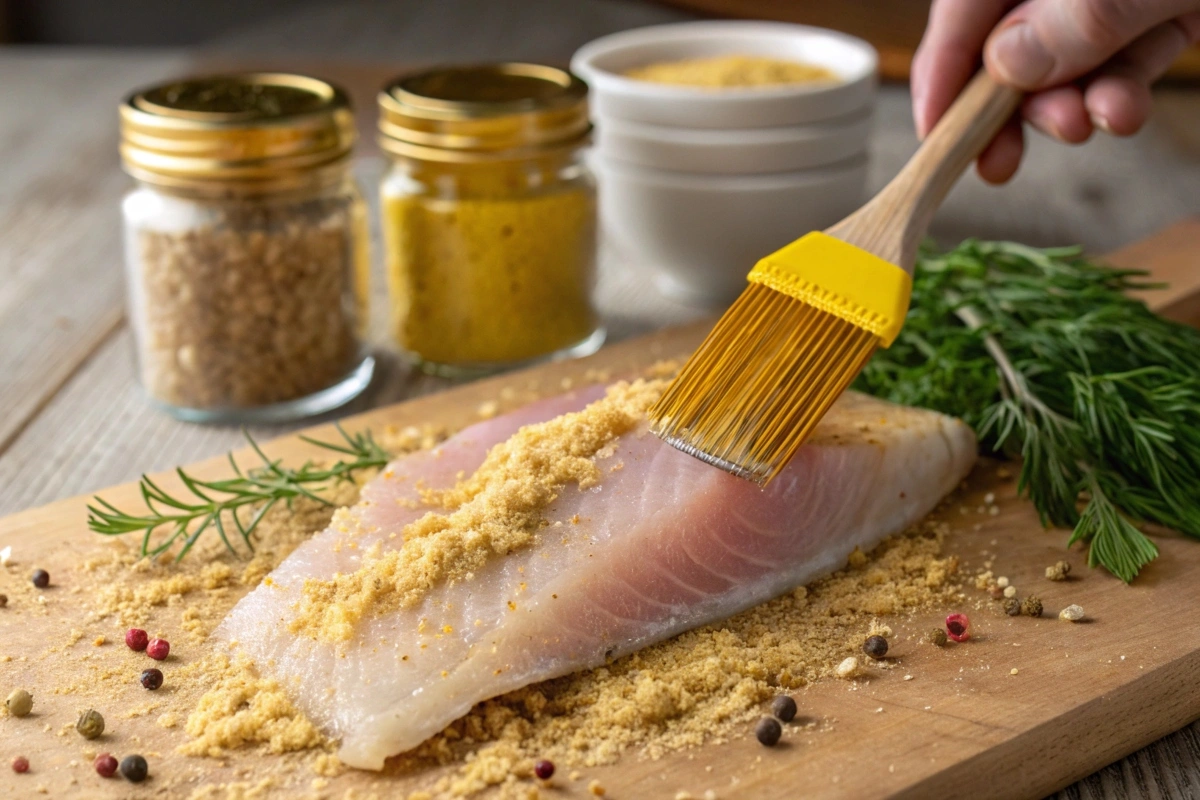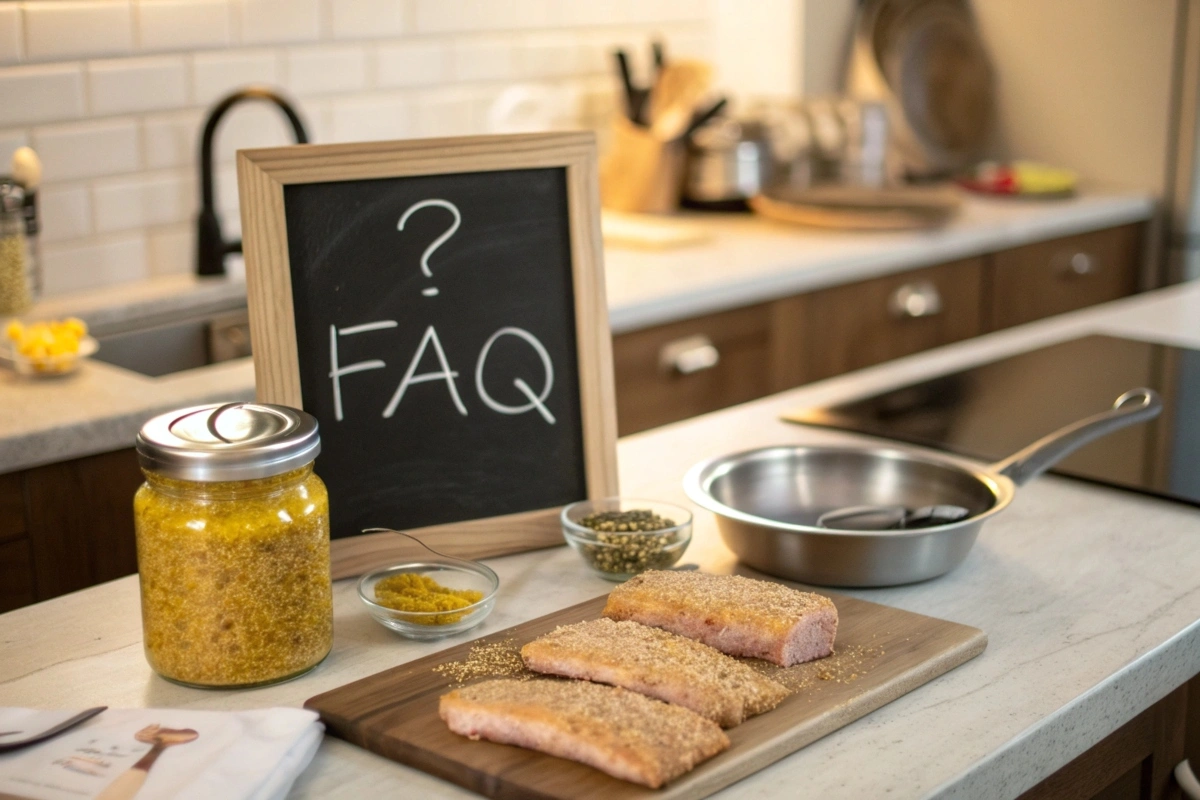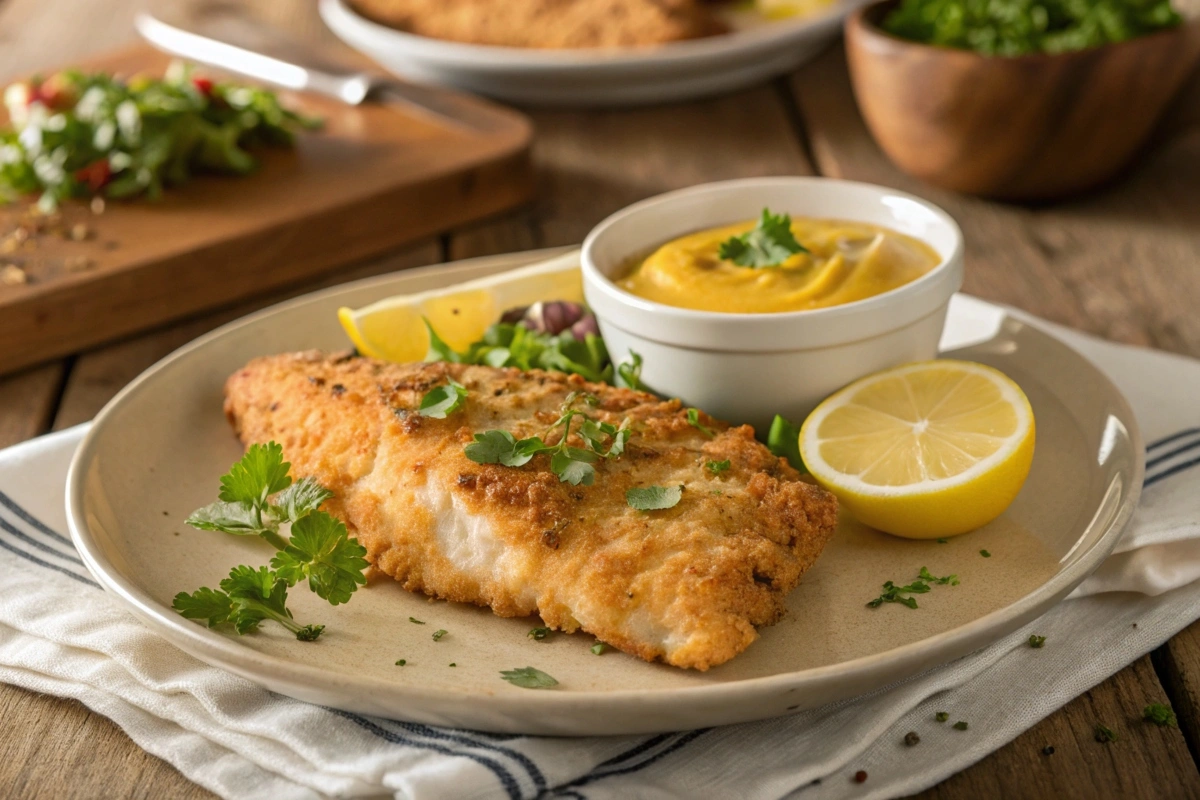Fried fish has been a timeless favorite across cuisines, celebrated for its crispiness and rich flavors. But have you ever wondered why some cooks swear by adding mustard to fish before frying? This seemingly simple step is steeped in both science and tradition, enhancing texture, flavor, and more. In this article, we’ll dive deep into the fascinating chemistry of mustard, explore its culinary and health benefits, and even look at the historical roots of this practice. By the end, you’ll understand why mustard isn’t just a condiment, it’s a game-changer.
Introduction to the Use of Mustard in Frying Fish
Overview of Mustard as a Pre-Frying Ingredient
Mustard is more than just a tangy spread for sandwiches or hot dogs. When it comes to frying fish, it transforms into an essential ingredient. Coating fish with mustard creates a thin, flavorful layer that enhances the dish in ways that go beyond taste. This layer not only helps seasonings cling to the fish but also prevents the coating from slipping during frying.
Plus, it’s a natural tenderizer. The acids in mustard break down proteins, making the fish more tender while retaining moisture. And, for those who shy away from strong fishy smells, mustard neutralizes odors, leaving a clean and appealing aroma.
Historical Context and Regional Popularity
The practice of using mustard on fish traces its roots to French cuisine. French chefs introduced this technique to preserve moisture while adding complexity to the dish. Over time, it gained popularity in the American South, where home cooks added their own twists, like combining mustard with cornmeal or breadcrumbs for a crunchy crust.
Today, mustard-coated fried fish is a beloved staple in many coastal regions. Whether you prefer Dijon’s tang or the mild sweetness of honey mustard, this method has something for everyone.
Stay tuned as we explore the science, benefits, and techniques that make mustard-fried fish a culinary standout!
Chemistry Behind Using Mustard on Fish
How Mustard Enhances Flavor
One of the key reasons chefs and home cooks use mustard on fish before frying is its ability to enhance flavor. Mustard is packed with bold, tangy notes that complement the natural richness of fish. When applied as a coating, it infuses the fillet with a layer of taste that balances both savory and slightly acidic elements. This harmony is why many ask, “Why do you put mustard on fish before frying? and the answer lies in its flavor-boosting properties.
Additionally, mustard acts as a carrier for other seasonings. Whether you mix it with garlic, paprika, or herbs, the paste ensures that every spice sticks to the fish, creating an even flavor distribution.
Tenderizing Properties of Mustard
The tenderizing power of mustard is another reason it’s so popular. Mustard contains vinegar or other acidic components, which break down the proteins in fish. This chemical reaction softens the fillet, resulting in a juicy and tender texture once fried. What’s more, this process also shortens cooking time, helping the fish cook evenly without drying out.
Role of Acidity in Protein Breakdown
Acidity is the secret behind mustard’s magic. When applied to fish, the acids in mustard denature its proteins, essentially “pre-cooking” the fillet before it hits the pan. This not only enhances tenderness but also creates a more stable structure, allowing the fish to maintain its shape during frying. For those wondering, “Why do you put mustard on fish before frying? it’s this scientific interaction that makes mustard so effective.
Benefits of Using Mustard in Fried Fish

Flavor Enhancement and Texture Improvement
Using mustard before frying fish does more than add a tangy kick, it transforms the dish entirely. The mustard coating acts like an adhesive, holding breadcrumbs or cornmeal firmly to the fillet. This ensures an even, golden-brown crust that stays intact through frying. Plus, mustard’s sharp, zesty profile cuts through the richness of the fish, making each bite taste lighter and fresher.
Moisture Retention During Frying
One of mustard’s hidden talents is its ability to lock in moisture. Fish can dry out easily during frying, but the mustard layer creates a barrier that prevents this. As the fish fries, the mustard keeps it juicy and tender inside, while forming a crunchy outer shell.
Neutralizing Fishy Odor
Fishy smells can be off-putting, especially for those sensitive to strong aromas. Mustard, with its sharp and acidic components, neutralizes these odors effectively. When combined with herbs or spices, the result is a dish that’s aromatic and inviting, not overpowering.
By now, you might see why so many cooks insist, “Why do you put mustard on fish before frying?” From flavor to texture, mustard brings benefits that make fried fish a must-try culinary experience.
Techniques for Frying Fish with Mustard
Preparing the Fish: Mustard as an Adhesive for Coatings
When you ask, “Why do you put mustard on fish before frying?”, one practical answer lies in its sticky, adhesive nature. Mustard acts as the perfect base layer, ensuring that breadcrumbs, cornmeal, or any other coating sticks uniformly to the fish. This adhesion prevents the coating from falling off during frying, resulting in a visually appealing, evenly fried fillet.
To prepare, simply brush a thin layer of mustard on the fish. Whether you use a tangy Dijon or a sweet honey mustard, the choice depends on your flavor preference. After applying the mustard, dredge the fish in your preferred coating mixture, ensuring every inch is covered.
Choosing the Right Type of Mustard
Not all mustards are created equal when it comes to frying fish. Dijon mustard, with its bold and tangy taste, works wonderfully for creating a robust flavor. Meanwhile, yellow mustard offers a milder, more neutral base that allows other seasonings to shine. If you’re in the mood for something unique, try spicy brown mustard for a hint of heat.
For a creative twist, combine mustard with herbs or spices to build a custom marinade. This enhances both the flavor and texture of the final dish.
Tips for Achieving a Crispy Texture
Getting the perfect crunch begins with hot oil, around 350–375°F. Coat the fish evenly, avoiding excess mustard that can cause uneven browning. Fry in small batches to maintain the oil’s temperature, and flip the fish gently to keep the crust intact.
For a similar recipe, explore the Hillbilly Fish Fry Seasonings Recipe on Dakota Recipes for inspiration.
Nutritional and Health Benefits of Mustard in Fried Fish
Overview of Mustard’s Nutritional Profile
Mustard brings more than flavor to the table; it’s a nutritional powerhouse. Rich in omega-3 fatty acids, mustard supports brain and heart health, making it a thoughtful choice for your frying process. It’s also packed with antioxidants and glucosinolates, compounds known for their detoxifying and cancer-fighting properties.
Adding mustard to your fish doesn’t just improve its taste but also increases its nutritional value. For those watching their calorie intake, mustard is low in calories and fat-free, making it an ideal choice for guilt-free indulgence.
Anti-Inflammatory and Heart-Healthy Properties
Mustard’s anti-inflammatory properties can reduce pain and inflammation in the body, making it a smart addition to your diet. It’s also a good source of selenium and magnesium, minerals that promote cardiovascular health.
Low-Calorie Alternative for Flavoring
Unlike heavy marinades or high-fat coatings, mustard enhances your dish without adding extra calories. It’s a natural, flavorful solution that keeps your fried fish light and healthy.
If you’re looking for more delicious ideas, check out the What Is the Best Fish Fry Seasoning? article for seasoning inspiration.
Historical and Cultural Evolution of Mustard-Fried Fish
Origins in French Cuisine
The origins of mustard-fried fish can be traced back to French culinary traditions. French chefs were pioneers in using mustard as a marinade, smothering fish fillets with Dijon mustard to create layers of flavor and tenderness. This technique allowed the fish to retain moisture during cooking while imparting a subtle tanginess.
As French cuisine influenced global cooking styles, this method traveled across borders and eventually reached the Americas. The question, “Why do you put mustard on fish before frying?”, likely arose as cooks adapted the technique for local ingredients and flavors.
Adoption in Southern Cooking and Regional Variations
In the Southern United States, mustard-fried fish became a culinary staple. Southern cooks added their twist, incorporating cornmeal into the coating for an extra-crispy crust. Over time, mustard-fried fish evolved into a beloved dish served with hush puppies, coleslaw, and other regional sides.
Today, the tradition continues with variations like spicy mustard marinades and honey mustard glazes. Whether at a backyard fish fry or a coastal seafood restaurant, mustard-fried fish is a testament to the blending of cultures and flavors.
Alternatives to Mustard for Preparing Fried Fish
Seasoned Flour Coatings
If mustard isn’t your preference, seasoned flour is a versatile alternative. A mixture of flour, paprika, garlic powder, and other spices creates a crispy, flavorful coating. To make it stick, you can use an egg wash or buttermilk as a base.
This method ensures a satisfying crunch without mustard, while still letting the natural flavor of the fish shine. For cooks who wonder, “Why do you put mustard on fish before frying?”, flour-based coatings offer a milder option with similar benefits.
Egg Wash and Breadcrumb Variations
An egg wash paired with breadcrumbs, cornmeal, or panko can create a golden, crunchy crust. This approach allows you to experiment with different seasonings and textures, from classic Italian breadcrumbs to light, airy panko.
For a creative twist, try combining yogurt or mayonnaise with your seasoning mix for a creamy marinade that locks in moisture. These alternatives maintain the tender texture and crisp coating that make fried fish irresistible, without relying on mustard.
For more ideas on achieving perfect fish coatings, explore additional recipes and tips online. The variety of options ensures there’s something for every palate, making fried fish a dish you can truly personalize.
FAQs

Why Does Mustard Work as a Tenderizer?
Mustard contains natural acids, such as vinegar, that break down proteins in fish. This tenderizing action helps the fish cook evenly while maintaining its moisture. Many cooks ask, “Why do you put mustard on fish before frying?”, and the tenderizing effect is a key reason. It ensures the fish stays soft and juicy, even after frying.
Can Any Type of Mustard Be Used?
Absolutely! While Dijon mustard is a popular choice for its bold flavor, yellow mustard works equally well as a milder alternative. Spicy brown mustard can add heat, and honey mustard brings a hint of sweetness. The choice depends on your taste preferences and the type of fish you’re frying.
What Other Dishes Benefit from Using Mustard?
Mustard isn’t just for fried fish, it’s a versatile ingredient. Use it as a marinade for grilled salmon, a tangy glaze for roasted chicken, or a flavor enhancer in potato salads. Its bold taste complements a wide variety of dishes, making it a staple in many kitchens.
If you’re looking for more recipes, consider exploring similar cooking methods to elevate your dishes. Mustard’s adaptability makes it a go-to ingredient for creative cooking.
Wrapping Up: Why Mustard is a Game-Changer for Fried Fish
Summary of Key Benefits
By now, the benefits of adding mustard to fish before frying should be crystal clear. From enhancing flavor and locking in moisture to creating a crispy crust, mustard does it all. It also tenderizes the fish, thanks to its acidic properties, and helps neutralize any fishy odors. For those asking, “Why do you put mustard on fish before frying?”, it’s evident that this ingredient plays a crucial role in both taste and texture.
Encouragement to Experiment with Mustard-Based Recipes
Don’t hesitate to get creative in your kitchen! Whether you prefer Dijon for its tang or spicy mustard for a kick, there’s a flavor for every palate. Try pairing your mustard-coated fried fish with coleslaw, hush puppies, or a zesty dipping sauce for a complete meal.
For those who want to try new techniques, experimenting with mustard-based marinades or coatings can lead to surprising and delicious results. This simple ingredient has the power to transform your dishes, making every bite memorable.
Incorporate mustard into your cooking routine and discover why it’s a game-changer, not just for frying fish but for elevating flavors across a wide array of dishes. Bon appétit!

